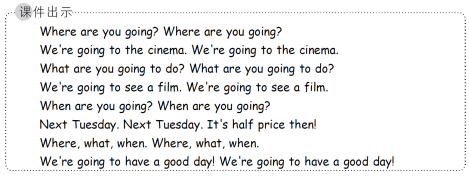人教pep六上英语 Unit 3 The fourth period第四课时教案
The fourth period(第四课时)
Part B Let’s learn & Role-play ![]()
▶教学内容与目标
课时教学内容 | 课时教学目标 |
Let’s learn | ·能够听、说、读、写单词和词组:dictionary, comic book, word book, postcard ·能够熟练运用“—Where are we going? —To the bookstore. I’m going to buy…”等句型描述自己要买的物品 |
Role-play | ·能够运用所学知识,根据自己的角色(顾客或者书店店员),完成角色扮演,达到在真实语境中用英语进行交流的目的 |
▶教学重点
1.能够听、说、读、写单词和词组:dictionary, comic book, word book, postcard。
2.能够熟练运用“—Where are we going? —To the bookstore. I’m going to buy…”等句型描述自己要买的物品。
▶教学难点
能够运用所学句型谈论在商店里购物的简单话题。
▶教学准备
PPT课件、课文录音、视频、卡片、实物等。
 ▶教学过程
▶教学过程
1
Step 1: Warm-up & Revision & Lead-in
1. Greetings.
2. Chant together.

3. Look and say.
Show the pictures of different places, activities and time. (出示课件) Lead students to practice the sentence structures in pairs. 
4. Lead-in.
Show the picture of John and Jack standing in front of the cinema. (课件出示:教材P27 Let’s learn板块John和Jack的图片)
T: John and Jack saw a film about space travel. Now they are in front of the cinema. Where are they going?
Encourage more students to discuss the question and say more answers.
 Step 2: Presentation
Step 2: Presentation
1. Listen and answer.
(1) Play the recording of “Let’s learn”. (课件出示:教材P27 Let’s learn板块的音频) Ask students to watch it carefully and try to find the answer to the question: Where are they going?
Lead students to get the answer: To the bookstore.
Then show some different stores on the PPT. (课件出示:不同商店的图片) Let students choose which one is the bookstore.
(2) Then show more pictures of a bookstore on the PPT. (课件出示:关于书店的图片)
Ask the questions. Freely talk with students. Give some help to students if they need about the third question.
Questions:
①Do you often go to the bookstore?(Yes, I do./No, I don’t.)
②What can we do in the bookstore?(We can buy books in the bookstore.)
③What books can we buy in the bookstore?(We can buy comic books, dictionaries, postcards, word books and so on.)
(3) Show the picture of “Let’s learn”. (出示课件) Play the cartoon of this part for the second time. (出示课件) Ask students to watch it carefully and try to find the answer to the question: What book is John going to buy?
Lead students to get the answer: John is going to buy a new comic book.
2. Learn the new words and phrases.
 (1) Take out a real comic book. Let students pass it one by one to see the content quickly.
(1) Take out a real comic book. Let students pass it one by one to see the content quickly.
T: After looking over this book, who can tell us the main features of this book?
S1: It has so many pictures in this book.
S2: It has very few words and sentences.
…
T: You all get the key points! It mainly uses pictures to tell the stories. It’s the comic book.
Show the picture of a comic book on the PPT to teach the phrase “comic book”. (课件出示:comic book的相关内容) Write down the phrase “comic book” on the blackboard and lead students to practice reading it for three times.
(2) Continue to take out a word book. Let students pass it one by one to see the content quickly.
T: After looking over this book, who can tell us the main features of this book?
S1: It has so many words in this book.
S2: We can read these words in this book.
…
T: There are so many words in this book. It can help us to learn more words. I want to know if someone can tell us the name of this book.
Lead students to speak out the answer: word book. Show the picture of a word book on the PPT to teach the phrase “word book”. (课件出示:word book的相关内容)
Write down the phrase “word book” on the blackboard and lead students to practice reading it for three times.
T: Now we know “comic book” and “word book”. In our schoolbag, we also have maths book, Chinese book and so on.
(3) Take out a postcard this time.
T: What’s this? What can we do with it?
S1: I know, we can write our words on it. And we can send it in the post office.
…
T: Brilliant! It is a postcard. (post + card=postcard). We can send this card in the post office.
Show the picture of a postcard on the PPT to teach the word “postcard”. (课件出示:postcard的相关内容)
Write down the word “postcard” on the blackboard and lead students to practice reading it for three times.
(4)T: We’ve learned a new word and two phrases in this class. There are still many words we don’t know. If we don’t know a word, what tools can we use?
Take out a dictionary to teach the word “dictionary”. Ask students to take out their own dictionaries.
Show the picture of a dictionary on the PPT. (课件出示:一本词典的图片)
Write down the word “dictionary” on the blackboard and lead students to practice reading it for three times.
(5) Lead students to put all kinds of books on the desk in the front of the classroom to build a bookstore. There are not only the books we have learned today, but also some newspapers, magazines, storybooks and so on. Students can also put their own books on the desk.
T: We’ve got a bookstore now. But we need to complete some tasks to make it open.
Step 3: Practice
 1. Task 1: Read aloud.
1. Task 1: Read aloud.
Show the picture of “Let’s learn”. Play the recording of this part. (课件出示:教材P27 Let’s learn板块的图片和音频) Ask students to try to read the words, the phrases and the dialogue after the recording.
2. Task 2: Play a game—What’s missing?
Show the words and phrases in “Let’s learn” on each PPT.(出示课件)Students speak out the missing word or phrase loudly and quickly. After four rounds, students are required to read all the four words and phrases.
3. Task 3: Act out the dialogue.
Show the pictures of the words and the phrases in “Let’s learn” one by one on the PPT. (课件出示:依次展示教材P27 Let’s learn板块的单词和词组的图片) Ask a question each time. The question is “What are you going to buy?” Students should answer it according to the picture.
Let students work in pairs. Try to practice the dialogues by using the words, the phrases and the sentence structures in this part. Then ask several pairs to act out their dialogues.
4. Task 4: Make your own dialogues.
Students ask and answer with each other to see what he/she is going to buy in a bookstore by using the sentence structures “—What are you going to buy? —I’m going to buy…” Make a model:
A: What are you going to buy in the bookstore?
B: I’m going to buy a storybook.
Provide some pictures of different kinds of books to help students make their dialogues on the PPT. (课件出示:不同种类的书的图片)
Step 4: Consolidation & Extension
 “The bookstore is open.”
“The bookstore is open.”
1. Role-play.
T: You’ve done all the tasks successfully, so our bookstore is open now. I’ll divide you into several groups. Each group has four people. Each group has one student to be the shop assistant. The others are customers. The bookstore can sell all kinds of books. Imitate the scene in the part of “Role-play” to make your own dialogues about shopping in a bookstore.
Make a model first. And provide the sentence structures of the dialogue. (课件出示:对话练习的框架)
2. Show time.
Invite several groups to come to the bookstore in the front of the classroom. Show their dialogues to the class. Provide some help when necessary.
3. Evaluation.
The teacher and students vote the best performance, the best dialogue, the most interesting group and so on. Then encourage students to make their own bookstore in groups. Try to sell and buy books in the bookstore.
4. The emotional education.
- Read good books, and you will be better and better.
1
▶板书设计

▶作业设计
Copy the key words and phrases in this lesson.
▶教学反思
1.热身和导入部分,从复习与本课相关的知识入手,通过旧知导入新知,教学过程由浅入深,由易到难,层层深入。
2.用直观实物教学法等多种记忆法来指导学生记忆词汇,使学生更好地掌握所学内容。
3.巩固新知的阶段,让学生模拟生活场景,让英语走进生活,用英语来解决实际问题。这样不仅巩固了所学的语言,还使学生体会到了英语的实用性和趣味性。
4.书设计清晰明了,重点突出,起到了很好的辅助作用。![]()
▶Teaching Contents & Teaching Aims
Let’s learn
·Be able to listen, speak, read and write the words and the phrases: dictionary, comic book, word book and postcard.
·Be able to use the key sentence structures “—Where are we going? —To the bookstore. I’m going to buy…” to describe what they want to buy.
Role-play
·Be able to use what they have learned to play according to their roles (customers or bookstore clerks), so as to communicate in the real context.
▶Teaching Priorities
·Be able to listen, speak, read and write the words and the phrases: dictionary, comic book, word book and postcard.
· Be able to use the key sentence structures“—Where are we going? —To the bookstore. I’m going to buy…” to describe what they want to buy.
▶Teaching Difficulties
Be able to use the sentence structures to talk about the simple topic of shopping in the store.
▶Teaching Procedures
Teaching Stages | Teacher’ s Activities | Students Activities | Teaching Purposes |
Warm-up & Revision & Lead-in | 1. Greetings. 2. Chant together. 3. Look and say. 4. Lead-in. Show the picture of John and Jack standing in front of the cinema and ask a question: Where are they going? | 1. Greetings. 2. Chant together. 3. Look at the pictures. Practice the sentence structures in pairs. 4. Discuss and answer the question. | Help students review the sentence structures of the three special question words with the chant. The lead-in part enables students to enter into the study of the new lesson with doubts, which improves the initiative and enthusiasm of learning. |
(续表)
Teaching Stages | Teacher’ s Activities | Students’ Activities | Teaching Purposes |
Presentation | 1. Watch and answer. (1) Play the recording. (2) Ask three questions. (3) Show the picture and play the recording again. | (1) Listen to the recording carefully to get the answer to the question: Where are they going? (2) Try to get the answers to the three questions. (3) Listen to the recording again and try to guess the answer to the question: What book is John going to buy? | Use questions to lead in the topic of bookstore shopping. Let students listen with the questions and check the answers. Let students get into the lesson by connecting with their real life. |
2. Learn the new words and phrases. Teach the phrases “comic book, word book” and the words “postcard, dictionary” in different ways. Lead students to put all kinds of books on the desk in the front of the classroom to build a bookstore. | Observe the different kinds of books carefully. Answer the teacher’s questions to learn the new words and phrases in this lesson one by one. Build a bookstore in the front of the classroom. | Help students understand and learn the names of different kinds of books. Students are asked to finish the tasks before the bookstore is open, which gives them more motivation for further study. | |
Practice
| 1. Task 1: Read aloud. Show the picture and play the recording of this part. 2. Task 2: Play a game—What’s missing? 3. Task 3: Act out the dialogue. 4. Task 4: Make your own dialogues. Provide some pictures to help students make dialogues. | 1. Read the words, the phrases and the dialogue after the recording. 2. Speak out the missing words or phrases. 3. Practice in pairs and act out the dialogues. 4. Ask and answer with each other to see what he/she is going to buy in a bookstore. | The exercises are designed from easy to difficult. It’s a good training of the new words, phrases and sentence structures of the lesson. And set the stage for the next part. |
Consolidation & Extension | “The bookstore is open.” 1. Role-play. Divide students into several groups. Ask them to make their own dialogues about shopping in a bookstore. 2. Show time. Invite several groups to show their dialogues to the class. 3. Evaluation. Encourage students to make their own bookstore in groups. 4. The emotional education. | 1. Make dialogues about shopping in a bookstore. 2. Show their dialogues to the class. 3. Vote the best performance, the best dialogue, the most interesting group and so on. Sell and buy books in the bookstore they open. 4. Realize the importance of reading books. | The bookstore is open, and students’ performances push the whole class to the climax. Achieve the language output. Help students apply the language to the real life situation. |
Homework | 1. Copy the key words and phrases in this lesson. 2. Do the exercises. | ||
1
